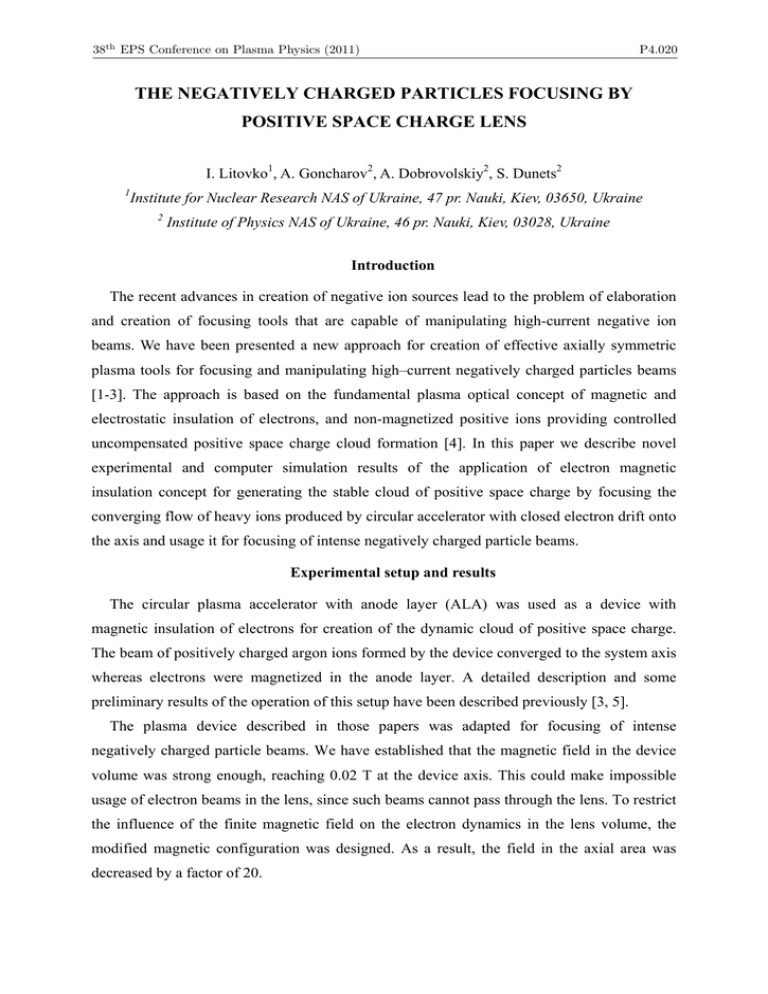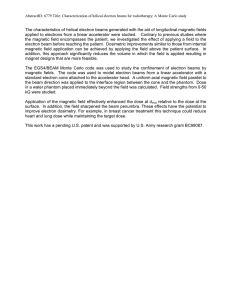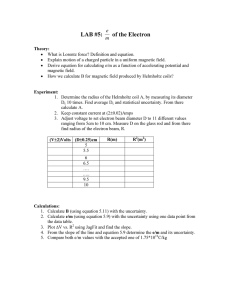the negatively charged particles focusing by positive space charge
advertisement

38th EPS Conference on Plasma Physics (2011) P4.020 THE NEGATIVELY CHARGED PARTICLES FOCUSING BY POSITIVE SPACE CHARGE LENS I. Litovko1, A. Goncharov2, A. Dobrovolskiy2, S. Dunets2 1 Institute for Nuclear Research NAS of Ukraine, 47 pr. Nauki, Kiev, 03650, Ukraine 2 Institute of Physics NAS of Ukraine, 46 pr. Nauki, Kiev, 03028, Ukraine Introduction The recent advances in creation of negative ion sources lead to the problem of elaboration and creation of focusing tools that are capable of manipulating high-current negative ion beams. We have been presented a new approach for creation of effective axially symmetric plasma tools for focusing and manipulating high–current negatively charged particles beams [1-3]. The approach is based on the fundamental plasma optical concept of magnetic and electrostatic insulation of electrons, and non-magnetized positive ions providing controlled uncompensated positive space charge cloud formation [4]. In this paper we describe novel experimental and computer simulation results of the application of electron magnetic insulation concept for generating the stable cloud of positive space charge by focusing the converging flow of heavy ions produced by circular accelerator with closed electron drift onto the axis and usage it for focusing of intense negatively charged particle beams. Experimental setup and results The circular plasma accelerator with anode layer (ALA) was used as a device with magnetic insulation of electrons for creation of the dynamic cloud of positive space charge. The beam of positively charged argon ions formed by the device converged to the system axis whereas electrons were magnetized in the anode layer. A detailed description and some preliminary results of the operation of this setup have been described previously [3, 5]. The plasma device described in those papers was adapted for focusing of intense negatively charged particle beams. We have established that the magnetic field in the device volume was strong enough, reaching 0.02 T at the device axis. This could make impossible usage of electron beams in the lens, since such beams cannot pass through the lens. To restrict the influence of the finite magnetic field on the electron dynamics in the lens volume, the modified magnetic configuration was designed. As a result, the field in the axial area was decreased by a factor of 20. 38th EPS Conference on Plasma Physics (2011) P4.020 The experiments on electron beam focusing by the lens with a positive space charge have been carried out on a setup that is shown in Fig. 1. An electron beam (8) from the electron source passes through the lens volume (5-7) to the sectioned collector (9-13). The beam current is about 300 mA, energy is in a range of 7...25 keV, diameter – 6 cm, pulse duration 120 mks. Maximum anode potential is up to 2 kV. Fig. 1. The scheme of the setup. Electron source: 1 – plasma electron source, 2 – hollow anode, 3 – emission grid, 4 – accelerating electrode. Plasma lens: 5 – permanent magnets, 6 – anode, 7 – cathode. 8 – electron beam, 9,10 – collector rings, 11 – isolators, 12 – shield, 13 – slide rod. The lens discharge current is up to 20 mA under pressure of 10-5-10-4 torr of argon. We study the electron beam current distribution along radius with a sectioned collector. The collector has 4 symmetric rings coaxial to the symmetry axis. The collector distribution of the electron beam current with energy of 8 keV is shown in Fig. 2. Traces illustrate the effect of the positive space charge on a beam. We can see this impact is very weak, especially as compared with the effect of the magnetic field in the lens volume. A low magnitude of the beam compression can be explained by a strong beam focusing in the magnetic field. Fig. 2. The radial and temporal current density distribution of the electron beam. The beam energy is 8 keV. Collector rings are numbered from the beam center to its periphery. The collector position is 2 cm from the lens Theoretical and simulation results In previous works has been investigated possibilities creation of the positively charged space charge cloud [3,5,6]. It has been shown that in assumptions about electrons magnetizing in the anode layer the stable cloud of the positive space charge will be created at the axis. Ions 38th EPS Conference on Plasma Physics (2011) P4.020 are stored in the cylinder volume until their own space charge creates a critical electric field. This field forces ions to leave the volume and the system comes to dynamic equilibrium after some relaxation time. The simulations have been done for ion beams Ar+ and Xe+ with maximal energy from 1 keV to 3 keV and total current 20 mA that moved with angular distribution according to cosine’s low in the magnetic field that reach 0.01 T on the system axis and about 0.07 T near electrodes region. It have been shown that the maximum of the potential for Ar+ ions (~550-650 V) is in the coaxial region around the axis, but the maximum for Xe+ ions (~ 750-800 V) is at the axis and calculated ion density that could accumulate around system axis reaches 0.1·1010 to 0.27·1011 cm-3. Thus the possibilities formation of the focusing stable space charge cloud was demonstrated. Now we investigated transport electron beam (energy from 5 to 20 keV) through this dynamical cloud. For correct description of such system we must solve equations for ions and electrons parts together. Thus previous equation system [3,6] has been modified and equations for electron’s motions and the law of charge conservation ∇ ⋅ j = 0 have been added. Poisson ρ equation had been changed to form: ∆ϕ = ε , where ϕ – is the electric potential, ρ=( ρi – ρ e) – space charge density, ρi, ρe –ion and electron density, ε – the permittivity. The Ar+ ion beam with total current 20 mA and maximal energy 2keV (with narrow energy and angle distribution) had been used for stable positive charge cloud creation. Simulation box had been chosen as cylinder with diameter 100 mm and length 600mm. Modeling PL has diameter 80 mm and length 10mm and has been placed in begin of the box. The magnetic field reach 0.001 T on the axes, thus magnetic focus lies behind electrostatic focus. The maximal potential in cloud was reaching about 580V. The electron beam with energy 5keV (transverse - 5 eV) and different currents passing through such PL were investigated. The results computer simulations are shown in Fig. 3. Ones can see that if for small current (<300mA) beam focusing is saving but strong beam current destroy cloud in short time and diverge. Ar+ ions, coming from lens electrodes has time for space charge cloud density renew for small current e-beam (<300mA). For bigger current (~300mA) some part of ions comes out from cloud with e-beam that decrease cloud potential, as it could seen from middle image in Fig. 3 - maximal cloud potential reduces from 580 to 396 V. For high current (>500mA) significant part of cloud particles are carries out by e-beam and new ions coming from electrodes couldn’t reconstruct the cloud, thus it destroys and PL focusing properties has been lost. 38th EPS Conference on Plasma Physics (2011) P4.020 Fig. 3. Electron beam trajectories and cross-sections for beam current 0.1, 0.3 and 1A (from top to bottom) 4. Conclusion The possibility of focusing high-current electron beams by proposed plasma lens has been shown experimentally and by simulation. Small size of the beam compression ratio that are observed on experiment, could explained by the influence on the beam of the scattering magnetic field of the source that ions of dynamic space charge generates. The distribution of the magnetic field takes the form of a short magnetic lens and its value is that it focuses the electron beam equalizer or even stronger than electrostatic plasma lens. Further development in research and development of plasma lenses that is suitable for focusing and manipulating of the negatively charged particles intense beams (particularly electrons), associated with the need decrease of the magnetic field in the beam transport region radically. Optical properties of magnetic lens depend on the particle masses and for ion beams it is much smaller than for electron. In contrast, optical properties of the space charge plasma lens does not depend on the particle masses and can be effectively used to focus beams of negative ions. References [1] A. Goncharov, I. Brown; IEEE Trans. Plasma Sci., Vol. 32 - 1, 2004, pp. 8083 [2] A. Goncharov, A. Dobrovol’skii, S. Dunets, A. Evsyukov, I. Protsenko ; Problems of Atomic Science and Technology. Series: Plasma Physics (15). 2009, № 1, p. 150-152. [3] A. Dobrovolskiy, S. Dunets, A. Evsyukov, A. Goncharov, V. Gushenets, I. Litovko, and E. Oks.; Rev. Sci. Instrum. 81, 2010, 02B704. [4] Morozov and S. Lebedev. “Plasmaoptics” in Reviews of Plasma Physics. Edited by M.Leontovich, Consultants Bureau, New York, 1975. [5] A. Goncharov, A.Evsyukov, A. Dobrovol’skii, I. Litovko, Adv. Appl. Plasma Sci., Vol. 6, p.5-8, 2007. [6] A. Dobrovolskiy, S. Dunets, A. Evsykov, A. Goncharov, V. Gushenets, I. Litovko, E. Oks, IEEE Trans. Plasma Sci., will be published.



